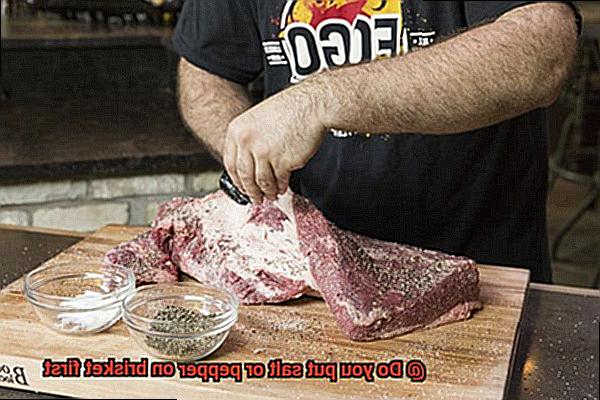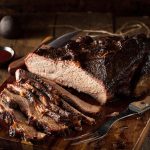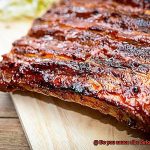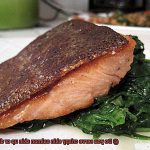Today, we’re diving into the sizzling world of brisket seasoning and settling one of the most hotly contested debates in culinary history: should you sprinkle salt or pepper on your brisket first? It’s a question that ignites passionate arguments and has pit pitmasters against each other for years.
But fear not, fellow grillers, because we’re here to guide you through this savory journey, uncovering the secrets, traditions, and delicious outcomes of each seasoning approach.
So, grab your tongs and get ready to unlock the key to transforming an ordinary slab of beef into a mouthwatering masterpiece.
Contents
What is Brisket?
Its rich marbling, tender texture, and mouthwatering flavors make it a favorite among grill masters. But what makes brisket truly exceptional? Join us on a journey to uncover the secrets behind the perfect brisket experience.
The Battle of the Seasonings:
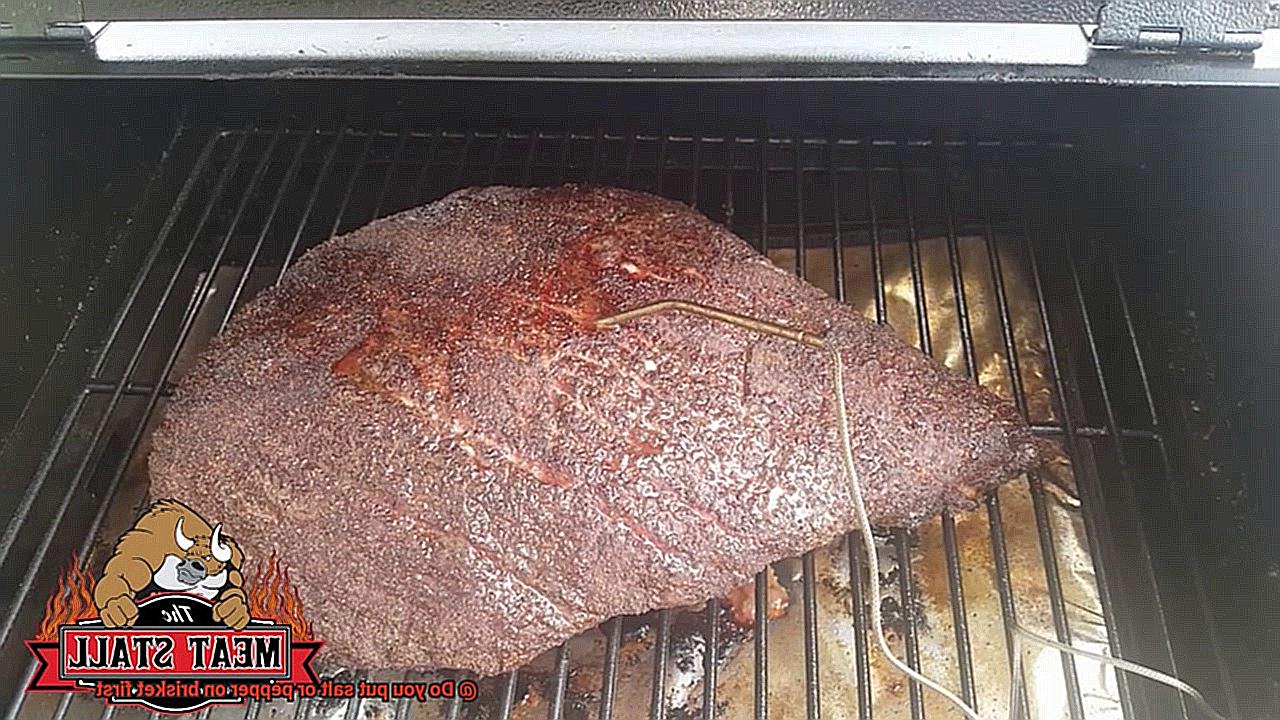
In the realm of brisket, one question ignites debates: should you put salt or pepper on brisket first? The answer lies in personal preference and desired flavor profiles. Let’s explore the arguments for both sides and find out which approach suits your taste buds.
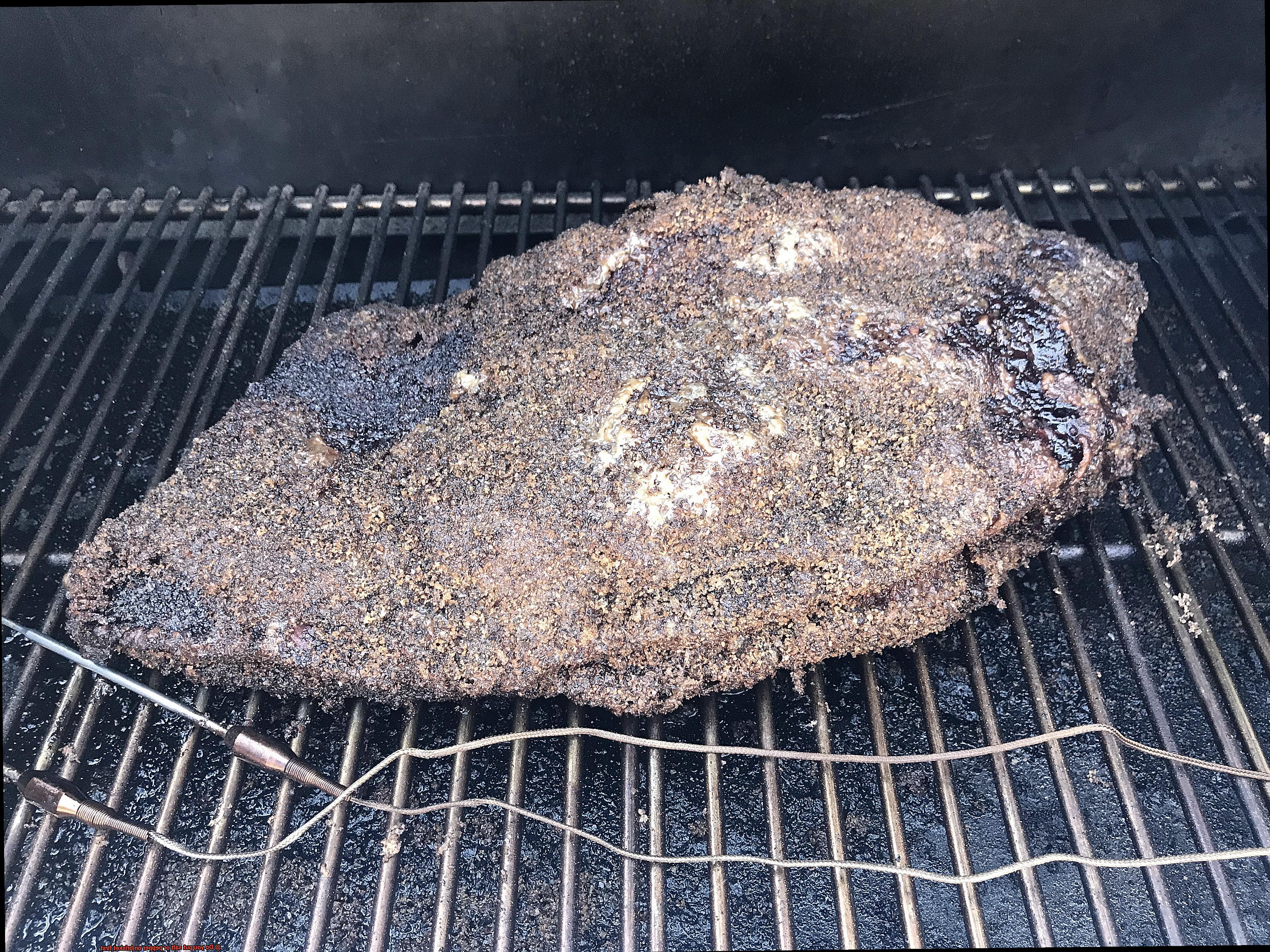
Salt First:
Advocates for salting first argue that it draws out moisture from the surface, resulting in a succulent and flavorful end product. Salt penetrates deep into the meat, enhancing its natural taste and creating an explosion of savory goodness with every bite. For those seeking a well-seasoned and juicy brisket, salting first is the way to go.
Pepper First:
On the other side of the debate are those who believe in the power of pepper as the initial seasoning. By applying pepper before salt, they create a crust with a robust and distinctive flavor that takes center stage without being overshadowed. This peppery punch is perfect for those who crave a bit of heat in every mouthful.
The Perfect Harmony:
Why choose sides when you can have both? Many grill masters opt for a combination of both salt and pepper simultaneously. This method ensures that both flavors are evenly distributed across the brisket’s surface, resulting in a harmonious marriage of taste.
Experimenting with different ratios and techniques can help you find the perfect balance for your palate.
Beyond Salt and Pepper:
While salt and pepper are classic choices for seasoning brisket, there is a whole world of spices waiting to be explored. From garlic powder to paprika, cumin to chili powder, the options are endless. Don’t be afraid to get creative and craft your own signature blend that will elevate your brisket to new heights of flavor.
Salt vs Pepper: Pros and Cons
In the spirited battle between salt and pepper for the title of ultimate brisket seasoning, both contenders bring their own unique pros and cons to the table. Let’s delve into the depths of flavor and explore the intricacies of these seasonings to determine which one will reign supreme for your brisket masterpiece.
Salt, the unsung hero of seasoning, possesses the remarkable ability to bring out the best in meat. It not only enhances the natural taste but also tenderizes the meat by breaking down proteins and drawing out moisture. When combined with other seasonings, salt can form a tantalizing crust on the surface of the brisket, adding an extra layer of texture and flavor that will make your taste buds dance with delight.
On the other hand, we have pepper, the fiery spice that adds a kick and depth to any dish. Its distinct earthy flavor complements the richness of the meat, creating a flavor profile that will leave your palate singing with joy. Pepper acts as a counterbalance to the saltiness, providing a well-rounded experience for your taste buds.
When it comes to penetration, salt takes the lead. Its smaller molecules allow it to seep deep into the meat’s fibers, distributing its savory essence evenly throughout. This ensures that every bite is perfectly seasoned from the inside out. Pepper, while it may not penetrate as deeply as salt, has its own advantage. When generously applied, it creates a flavorful crust on the surface of the brisket, adding an irresistible texture that will make you come back for more.
Now let’s turn up the heat and talk about how these seasonings handle temperature. Salt has a unique ability to draw out moisture from the meat, leading to a crispy exterior that will make your taste buds do a happy dance. However, if used excessively, salt can also dry out the meat, resulting in a less desirable texture. Pepper, on the other hand, can withstand high temperatures without losing its flavor or becoming bitter. So if you’re looking for a seasoning that can handle the heat, pepper is your go-to.
In the end, the choice between salt and pepper as the primary seasoning for your brisket comes down to personal preference. Do you crave the bold and spicy flavors that pepper brings to the table? Or do you prefer the balanced taste that salt provides? Perhaps you’re like me and can’t bear to choose between the two. Why not experiment with different ratios or even combine both to create a flavor explosion that will leave your guests begging for more?
Should You Put Salt or Pepper First?
This question has sparked numerous discussions among grill masters, each with their own theories and preferences. In this blog post, we will explore the factors to consider when deciding which seasoning to apply first and delve into the significance of both salt and pepper in creating a flavorful dish that will leave your taste buds begging for more.
The Power of Salt:
Salt is often hailed as the unsung hero of seasoning, enhancing the natural flavors of meat while tenderizing it through protein breakdown. When combined with other seasonings, salt forms a tantalizing crust on the surface of the brisket, adding texture and depth to each mouthwatering bite.
The Fiery Essence of Pepper:
Pepper brings a distinct flavor and aroma to the table, harmonizing perfectly with the rich meat. Its earthy essence creates a flavor profile that dances on your palate. While pepper may not permeate as deeply as salt, when generously applied, it forms an irresistible flavorful crust on the brisket’s exterior, adding an extra layer of enjoyment.
Finding the Perfect Balance:
The order in which you apply salt and pepper can impact flavor balance. Some argue that salt should come first, drawing out moisture from the meat and resulting in a better crust formation during cooking. Others believe that applying pepper before salt protects against excessive saltiness, allowing the pepper to penetrate deeper into the meat.
Experimentation is Key:
Ultimately, whether to put salt or pepper first depends on personal preference and desired outcome. It is recommended to experiment with both methods to find what works best for your taste preferences. Consider factors such as the type of salt or pepper used, cooking method, and marination duration to achieve desired flavor and tenderness.
Factors to Consider When Deciding Which Seasoning to Apply First
Preparing and seasoning a brisket requires careful consideration of various factors, including the order in which seasonings are applied. The debate over whether to apply salt or pepper first has long puzzled grill masters and culinary enthusiasts. In this article, we will delve into the key factors that should be considered when making this decision. These factors include flavor profile, salt penetration, pepper distribution, cooking method, and personal preference.
Flavor Profile:
The desired flavor profile is a crucial factor when deciding which seasoning to apply first on a brisket. Salt enhances the natural flavors of the meat while also tenderizing it. On the other hand, pepper adds a subtle spiciness and depth to the dish. If you want to highlight the meat’s inherent flavors, start with salt. If you crave a bolder and spicier taste, begin with pepper.
Salt Penetration:
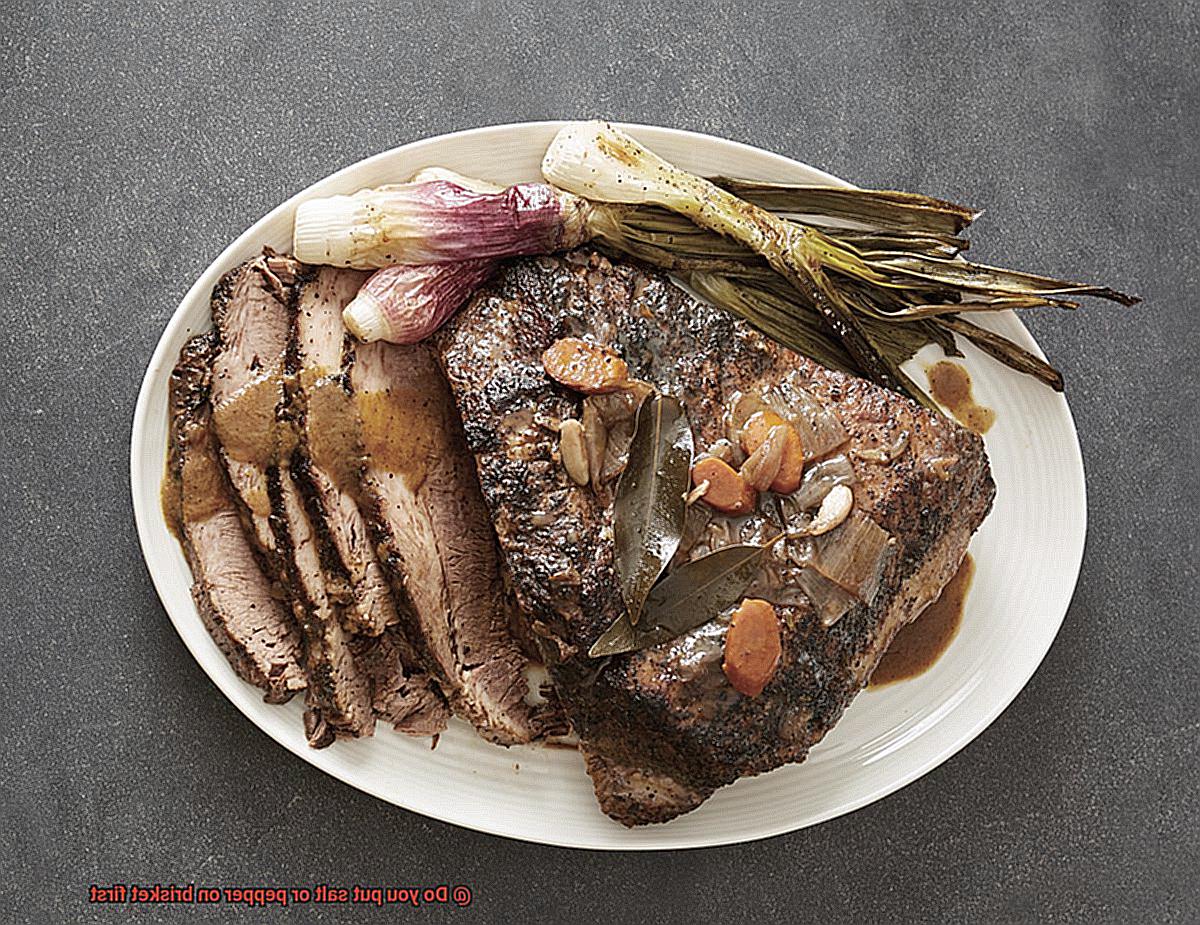
Salt has the remarkable ability to deeply penetrate the surface of the brisket, thereby enhancing its flavor throughout. By applying salt first, it has more time to work its way into the meat, resulting in a flavorful and well-seasoned brisket. However, caution must be exercised not to overdo it, as excessive salt can overpower other flavors.
Pepper Distribution:
Unlike salt, pepper primarily remains on the surface of the meat. Applying pepper before salt allows it to create a flavorful crust on the brisket, adding texture and visual appeal. However, if you apply salt first, some of it may dissolve into the meat juices and carry away some of the pepper’s flavor. Consider your preference for a milder or more intense peppery taste when making your decision.
Cooking Method:
The chosen cooking method also plays a significant role in determining which seasoning to apply first. If you plan on searing or grilling the brisket at high temperatures, applying salt first helps to form a delicious crust by drawing out moisture and enhancing browning.
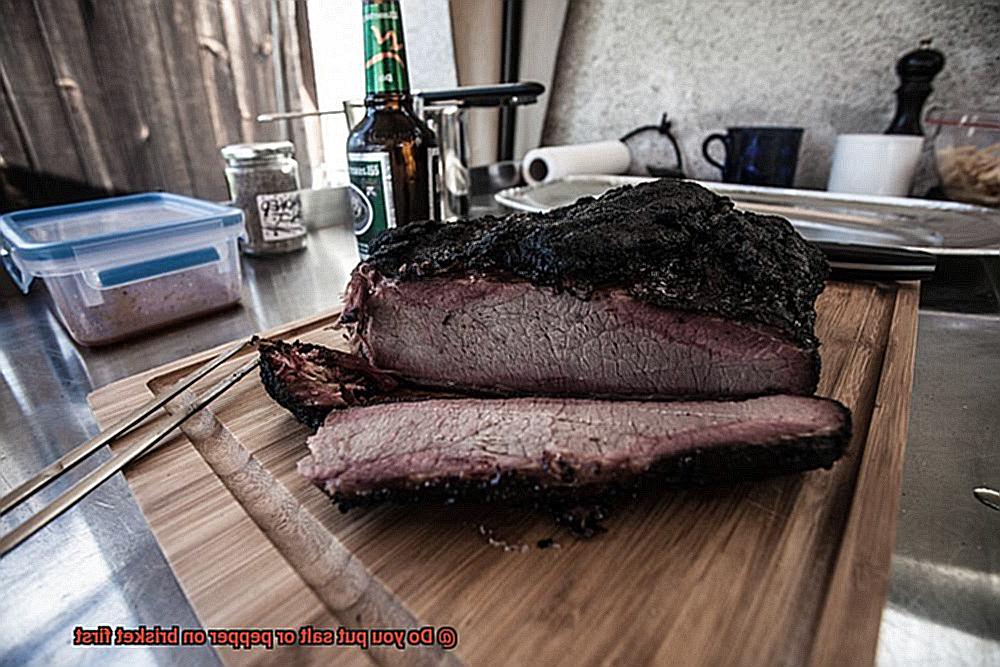
Conversely, if you are slow-cooking or smoking the brisket for an extended period, applying pepper before salt can help develop a flavorful bark on the surface.
Personal Preference:
Ultimately, personal preference is the key factor in deciding which seasoning to apply first. While there are general guidelines, experimentation with different approaches will help you discover your preferred method.
Some individuals may relish the intense flavor of salt applied first, while others may savor the unique taste and texture of a pepper crust. Trust your taste buds and adjust accordingly.
Why Some Believe Salt Should be Applied First
Today, we delve into the fascinating world of why some believe salt should be applied first, uncovering the mouthwatering reasoning behind this belief.
One compelling argument for salting first is the magical way it allows the salt to permeate the meat’s surface, infusing flavor throughout. By generously sprinkling kosher salt all over the brisket, you give it a chance to work its magic, drawing out moisture and creating a concentrated taste that will make your taste buds sing with joy. This technique, known as dry brining, not only enhances flavor but also improves texture, resulting in tender, succulent meat that melts in your mouth.
But the benefits don’t stop there. Salting first actually tenderizes the brisket by breaking down proteins. This process creates a juicy and tender end product that will have you reaching for seconds (and maybe even thirds.). The salt acts as a catalyst for other flavors to develop, transforming each bite into an explosion of tantalizing deliciousness.
What’s more, salting first creates a coveted crust or bark on the brisket’s exterior. As moisture evaporates from the surface, it leaves behind a concentrated layer of flavor that will have you licking your fingers in delight. It’s like a flavor bomb waiting to be unleashed with every bite.
Yet perhaps one of the most compelling reasons to salt first is the control it provides over the seasoning process. By establishing a solid foundation of flavor with salt before adding other spices or herbs, you ensure even distribution and prevent any clumping or unevenness in the final result. It’s all about achieving that perfect balance of flavors.
Of course, there are those who argue for pepper first, believing it adheres better to the meat’s surface and creates a pronounced peppery flavor. And then there are those who favor a combination of salt and pepper, claiming it provides a more balanced and evenly distributed seasoning. Ultimately, the choice is yours to make.
Why Some Prefer to Apply Pepper Before Salt
Today, we uncover the mouthwatering reasoning behind those who believe in salting first, where the magical power of salt permeates the meat’s surface, infusing flavor throughout like a symphony for your taste buds.
This technique, known as dry brining, not only enhances flavor but also tenderizes the brisket by breaking down proteins, resulting in succulent meat that melts in your mouth.
And let’s not forget about that coveted crust or bark on the exterior – a concentrated layer of flavor waiting to explode with each bite. With salt as the foundation, it provides control and even distribution of other spices or herbs, ensuring a perfect balance of flavors.
So go ahead, unleash the flavor bomb and let your senses dance with joy.
Flavor Penetration:
Pepper enthusiasts argue that pepper has a stronger and more distinct flavor compared to salt. By applying pepper before salt, they believe that the flavors of the pepper can penetrate the meat more effectively. This allows the vibrant heat and aromatic essence of pepper to seep into every fiber of the brisket, creating a symphony of flavors that excites the palate. Each bite becomes an explosion of zesty and robust sensations, transporting you to a culinary paradise.
Enhancing Natural Flavors:
When salt is applied first, it draws out moisture from the meat, resulting in a more flavorful and juicy brisket. As the salt works its magic, it enhances the natural flavors of the meat, elevating them to new heights. By adding pepper after salt, you allow these enhanced flavors to intertwine with the boldness of pepper, creating a harmonious marriage that tantalizes the taste buds.
Texture of the Crust:
For those who crave a textured and pronounced crust on their brisket, applying pepper before salt is the way to go. The rough texture of the pepper adheres to the meat better when applied first, creating a captivating crust that adds depth and complexity to each bite. As you sink your teeth into the tantalizingly textured exterior, your taste buds awaken to a symphony of flavors, as if experiencing an epicurean journey with every chew.
Even Distribution of Flavors:
Salt applied before pepper creates a more even distribution of flavors. As the salt dissolves and spreads evenly across the surface of the meat, it provides a consistent flavor throughout. Each bite is perfectly balanced, ensuring that no corner of the brisket is left untouched by the magic of seasoning. This meticulous attention to detail guarantees a dining experience that is nothing short of extraordinary.
Combining Both Flavors for a Harmonious Taste
When it comes to seasoning a brisket, the age-old debate of whether to apply salt or pepper first has divided pitmasters. Some argue that salt should always take the lead, while others believe that pepper should be the starting point. However, the secret to achieving a harmonious taste lies in combining both flavors in a balanced and thoughtful manner.
Salt is often hailed as the foundation of flavor in cooking. It has the power to elevate the natural taste of ingredients and bring out their best qualities. When generously applied to a brisket, salt acts as a tenderizer by drawing out moisture and breaking down proteins, resulting in a succulent and flavorful end product. It also forms a delicious crust on the surface of the meat, adding both texture and depth of flavor.
On the other hand, pepper brings a distinctive kick and complexity to dishes. Its unique heat can beautifully complement the richness of a well-cooked brisket. When combined with salt, pepper helps to harmonize the flavors by providing a subtle spiciness that cuts through the richness of the meat. Additionally, it adds visual appeal with its specks of contrasting color on the surface of the brisket.
To achieve the perfect balance of flavors, it is recommended to apply both salt and pepper to the brisket. However, the order in which they are applied can vary depending on personal preference and desired outcome. Some pitmasters prefer to start with salt, allowing it to penetrate the meat and draw out moisture before adding pepper. This method ensures that the salt has ample time to work its magic on the brisket. Others choose to apply both seasonings simultaneously, believing that this allows for better integration of flavors.
Regardless of your chosen approach, be generous with your seasoning. Ensuring that every inch of the brisket is coated guarantees that each bite is packed with flavor and no part of the meat is left bland. It’s important to note that the amount of seasoning needed may vary depending on the size of the brisket. Larger cuts may require more seasoning to adequately cover the surface area.
In addition to salt and pepper, many pitmasters incorporate other spices and herbs into their brisket rubs. Garlic powder, paprika, onion powder, and cayenne pepper are just a few examples of ingredients that can enhance the overall flavor profile of the meat. These additional seasonings can be mixed with salt and pepper to create a custom rub that suits individual taste preferences.
Other Spices and Rubs to Enhance the Flavor of Brisket
Imagine the scene: a perfectly smoked, tender brisket that melts in your mouth, bursting with an irresistible blend of flavors. While salt and pepper are the tried-and-true classics, why not take your brisket to new heights by venturing into the exciting world of spices and rubs?
In this comprehensive guide, we will delve into a multitude of options that will enhance the flavor of your brisket, leaving a lasting impression on your taste buds and those of your guests.
Paprika:
Let’s start with paprika – the secret ingredient that adds both a stunning pop of color and a subtle smoky flavor to your brisket. Whether you opt for the sweet or hot variety, paprika is a versatile spice that will elevate both the visual appeal and taste of your dish.
Garlic Powder:
Garlic powder, renowned for its savory taste, is a staple in countless spice blends. Its robustness beautifully complements the rich flavors of brisket, imparting depth and complexity to every bite.
Onion Powder:
Similar to its garlic counterpart, onion powder lends a delightful savory and slightly sweet note to your brisket. Acting as a harmonizer, it balances out the natural sweetness of the meat, resulting in a well-rounded flavor profile.
Chili Powder:
Are you craving some heat? Look no further than chili powder. This fiery spice adds a tantalizing kick that cuts through the richness of the meat, creating a harmonious balance of flavors that will leave you yearning for more.
Cumin:
For those seeking a Tex-Mex twist, cumin is your best friend. With its warm and earthy undertones, this aromatic spice complements brisket seamlessly, especially when combined with chili powder to create an irresistible rub.
Brown Sugar:
If you desire a touch of sweetness, brown sugar is a game-changer. It works wonders by creating a luscious caramelized crust on the meat while expertly balancing any spiciness or saltiness from other ingredients.
Mustard Powder:
Prepare to be pleasantly surprised by the versatility of mustard powder. This unassuming ingredient adds depth and tanginess to your brisket, contributing to its flavor profile and helping to create a delightful crust during cooking.
Herbs:
Don’t forget about the power of herbs. Fresh or dried thyme, rosemary, and oregano can take your brisket to new heights with their fragrant and herbaceous notes. Combine them with garlic and onion powder for an explosion of flavor that will transport your taste buds to culinary bliss.
PVycYj_PKgk” >
Conclusion
When it comes to seasoning a brisket, the question of whether to put salt or pepper first can spark some heated debates among barbecue enthusiasts. While there is no definitive answer, many pitmasters swear by the traditional method of applying salt before pepper.
Why? Well, salt helps to draw out moisture from the meat, enhancing its flavor and promoting a nice crust formation during the cooking process. By salting the brisket first, you create an initial layer of seasoning that penetrates deep into the meat fibers.
Once you’ve applied the salt, it’s time to add the pepper. Pepper brings a unique kick and depth of flavor to your brisket. Its aromatic qualities complement the richness of the beef and give it that signature smoky taste.
But don’t just stop at salt and pepper. Feel free to experiment with other seasonings like garlic powder, paprika, or even a secret blend of spices passed down through generations. The key is to find what works best for your taste buds and culinary style.
In conclusion, while there may not be a right or wrong way to season a brisket, starting with salt before adding pepper is a tried-and-true method that many pitmasters stand by.

